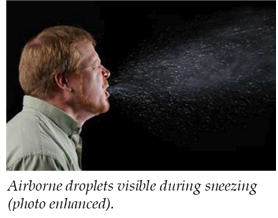The purpose of the aerosol transmissible diseases program is to eliminate or minimize occupational exposure to human pathogens transmitted by aerosol inhalation.
An aerosol is a solid particle or liquid droplet suspended in air (or another gas), even temporarily. Examples include a droplet with influenza virus emitted through a cough or sneeze, or a dust particle with hantavirus aerosolized by sweeping debris soiled with infected deer mouse urine.
An aerosol transmissible disease (ATD) is a disease that can be transmitted by either 1) inhaling particles/droplets; or 2) direct contact between particles/droplets and mucous membranes in the respiratory tract or eyes.
An aerosol transmissible pathogen (ATP), means a pathogen that, when present in an aerosol and with sufficient exposure, may result in disease transmission.

-
Diseases and pathogens for which airborne infection isolation or droplet precautions are required. (see §5199 Appendix A of the Cal/OSHA ATD standard)
-
Laboratory pathogens capable of causing disease through laboratory generated aerosols.
-
Zoonotic diseases/disease agents that are transmissible from animals to humans by aerosol (via droplets or airborne route) and capable of causing human disease.
Cal/OSHA Aerosol Transmissible Diseases (8 CCR 5199)
Note: Laboratory work with some pathogens, that usually only require biosafety level 2 precautions, are are specifically listed as being subject to the ATD standard. These are listed in §5199 Appendix D
Cal/OSHA standard 8 CCR 5199, "Aerosol Transmissible Diseases" requires employers to develop group-specific exposure control plans to prevent work-related illness from exposure to pathogens present in aerosols.
There are 3 types of group specific exposure control plans (ECPs) at SFSU:
The “Full Standard” ECP applies to Student Health Services.
The “Laboratory Employer” ECP applies mostly to the Biology department but applies to other laboratory operations as well.
The “Referring Employer” ECP applies to the University Police department.
The Cal/OSHA ATD Guide link below provides additional information regarding program requirements.
The following three workplaces at SFSU require exposure control plans.
Referring employer – UPD is subject to this section of the Cal/OSHA ATD Standard
Laboratory employers – Handle pathogens requiring biosafety level 3 controls or are listed in §5199 Appendix D.
Full-standard employers – All other employers covered by the ATD Standards that provide diagnosis, treatment, and other services to people requiring airborne infection isolation.
